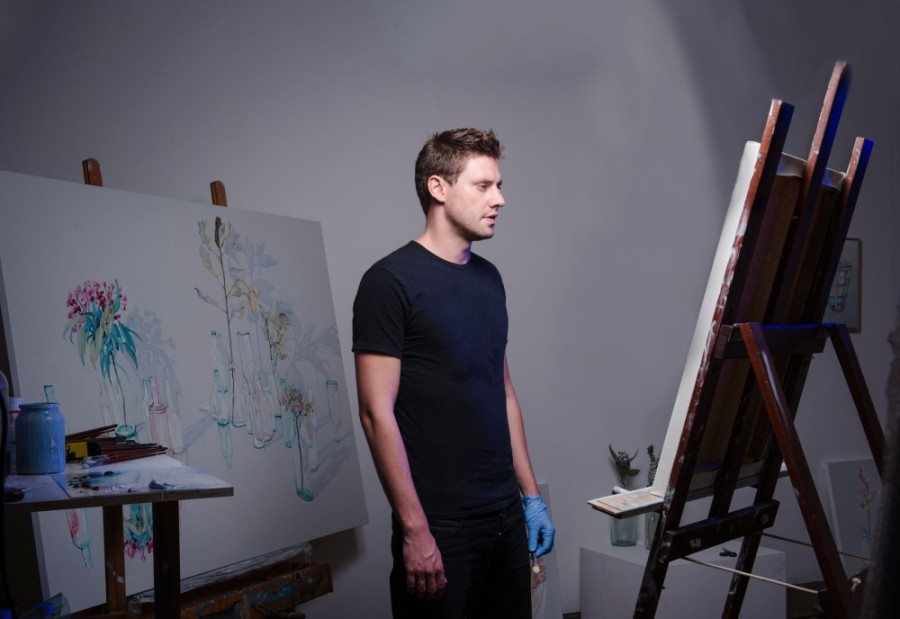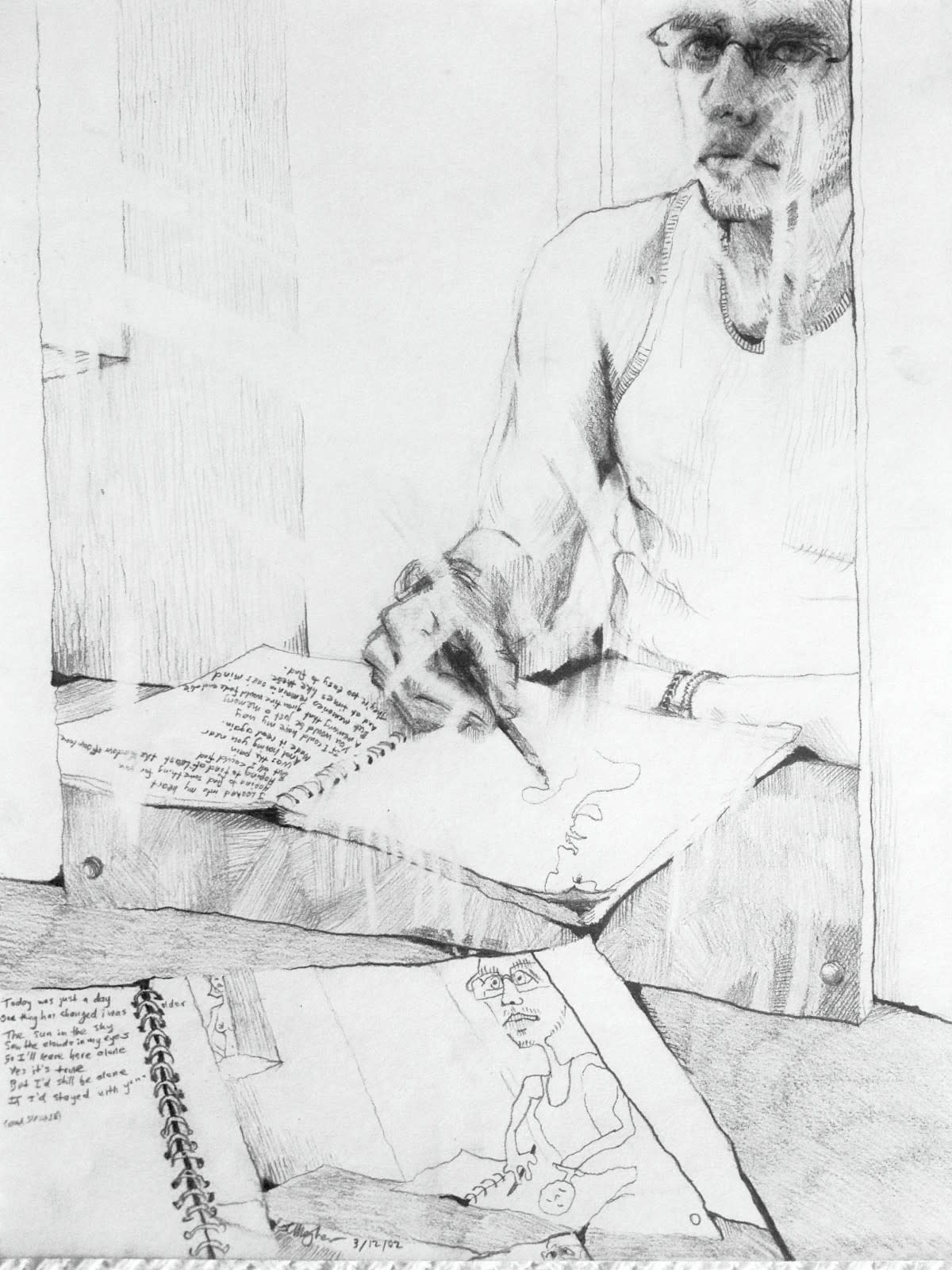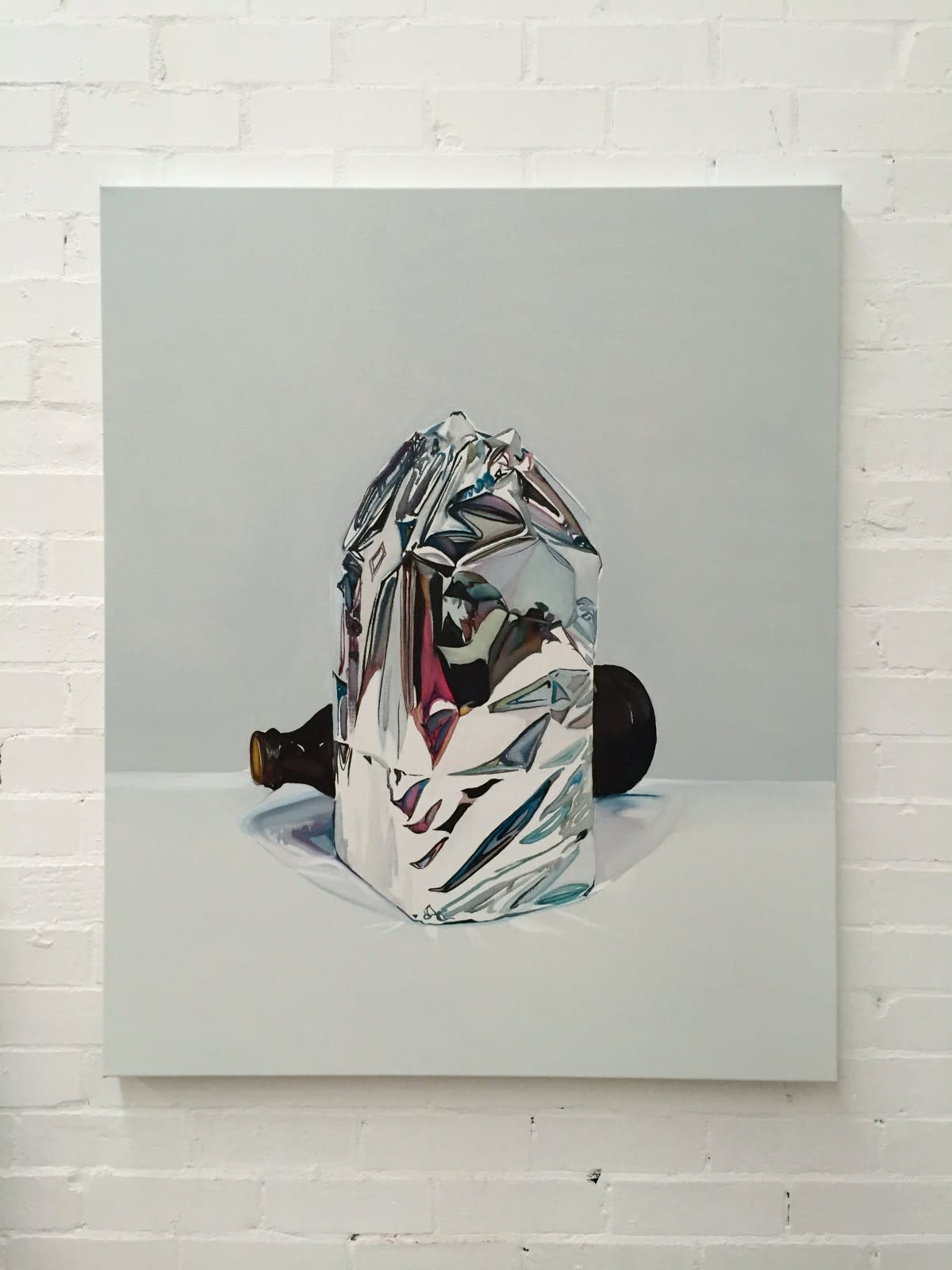Planes of Perspective

There’s something remarkably poetic and romantic about Julian Meagher’s work. From his soft washed out palettes of pink and blue, to his subtle technique of applying oils as if they were watercolours - everything seems so delicate and yet, the subjects upon which a large portion of his work is based, reflect something else entirely; masculinity, alcoholism, rituals and inherited history - bold topics that command attention.
As the second installation of our ongoing collaboration with Facebook and Instagram, we invited Meagher to take these narratives beyond a two-dimensional realm by creating a Cinemagraph.
This unique Facebook product breathes new life into static images by layering them with subtle animations that create almost hypnotic moments in time. They're silent, yet mesmerising and they're about to enter your News Feed in a much bigger way.
Here, we talk to Meagher about the artistic blood that runs deep within his family, the exciting opportunities platforms like Facebook and Instagram present for the artistic community and the inspiration behind his bespoke Cinemagraph...

Julian, thank you very much for taking the time to speak with us. Let’s take it right back to the start - growing up did you have a lot of exposure to art? Was your family full of creatives?
I grew up surrounded by art. My mum was an artist and so are a lot of my brothers and sisters. There was always somebody drawing or painting in the house. My godfather was a pathological collector. I have such strong memories of visiting his house with its walls packed to the roof with the most inspiring and eclectic works of art.
What sort of art forms were you dabbling in?
I was always drawn to paintings. Even at 13 I’d be painting in my room until 3am with oils, probably not the smartest move with all that turps looking back on it. Paint was the language that I liked to speak. I mean I always drew but it was painting that I could really get lost in.
In your early twenties you moved to Florence to study traditional oil portraiture for a year - that seems so romantic. What was that trip like?
I remember feeling so alone but so free. If I wasn't self-funding it I probably would have stayed over there for much longer. I remember painting one day in the garden smack bang in the middle of Florence and a tortoise climbed out of the irises and hung around for the afternoon with me...totally fantastical. But it was...oh, it was the first time in my life that I had the privilege to paint and think about art every day and get an insight into that creative world. It was incredible.
"Even at 13 I’d be painting in my room until 3am with oils. Paint was the language that I liked to speak. I mean I always drew but it was painting that I could really get lost in".

I’m sure you also learnt some invaluable techniques - in what way do you think that has influenced the way you approach your work today?
I think that technique is still the scaffold under which I apply paint. You can do so much with oil paint - but it is the underpainting and luminosity...that's what I really get excited by. I have gone down my own pathway with the technique to make the oil paint look really translucent.
Oil paints can be so so subtle. You can never mix the same colour twice no matter how hard you try. I’m a pretty quiet kind of guy - I’m more of an observer in the world rather than the noise most of the time. I think as you get older and you paint every day your style ends up mimicking your personality.
Fast forward a few years - you’d been training in medicine and finally did what many people only ever dream of doing - you put it all all on hold to focus on becoming a full time artist. What was it like completely changing your path?
I always wanted to be an artist. I always liked drawing and painting every day but it just took me a while to actually grow the balls to pursue it and try and make a profession out of it. Your twenties are a good time to do that when you can make those kind of decisions. You’ve got less responsibilities and you can take a few risks.
I think coming at it a little more mature was really beneficial. I think it’s very hard to paint every day. There is a stubbornness and work ethic and this pretty strong self-belief that you’ve got to have to turn up every day in the studio. You’ve got to ask what’s your drive going to be? Who are you making it for and why are you making it? There are a lot of question marks that come up all the time but the older you are sometimes the easier it is to ignore those questions (or answer them) and actually just keep working rather than hitting a wall. Coming at it a little bit later on I was a lot more determined, that’s for sure.
"I always wanted to be an artist. I always liked drawing and painting every day but it just took me a while to actually grow the balls to pursue it and try and make a profession out of it."

When you’re given a brief or have an upcoming show, what is your creative process? How do you approach it - is it different every time?
You know what? I actually paint my way into a show. I can’t just come up with an idea and then execute it. It’s all a process and to be honest there’s a lot of chance and luck in it. I never dictate where it’s going to go, I’m quite happy to let it grow and just chase down the things that are working really well.
With shows, you’ve got to let it grow organically rather than control it too much. You’ve got to be flexible, take a few risks and have a few failures and always be open to the new work. Challenge yourself just enough so it’s exciting, but not enough to have a break down over it!
We were really excited to be working with you on this collaborative project with Facebook. The first step was to present you with the Dan Winters image to form some sort of inspiration to tell a story through Cinemagraph. When you saw that image, what was your first response?
My first response was that it reminded me of those moments when you were young and off getting boozed with friends, or you were with your girlfriend once as a teenager, and took a stream of those photos and they suddenly became very personal records. You’d find them in your drawer years later and they’re these very real moments in time. I was also thinking they’re kind of like the original selfie! Before mobile phones, no one really ever turned a Nikon around and snapped themselves.
But what really influenced my creative was the idea of a photo booth being this room you hop into where you’re awake in the world and you close the curtain and you don’t quite know when the camera is going to snap you. It’s that one time where you really get to capture yourself, get away from it all and just be in that moment. They’re like a room, an escape pod…or a magic cupboard almost. It reminds of the children’s book ‘The Lion, the Witch and the Wardrobe’

What was it like creating a piece of work for a mobile video medium like Cinemagraph? Did this allow you explore your work differently, or add another dimension? What sort of challenges were you presented with?
The product is awesome. It’s so interesting to see a painting that’s moving. I almost just looked at it and I was like “holy shit” - it made me think ‘what are painters are going to be doing in 10 years’ time?’
Rather than being just another gimmick - there’s so much scope to add a whole other layer to your work and your story. There’s something really mesmerising about it.
Whenever we see tech mixed with art - because we haven’t seen it before - it can be a little challenging but once we become familiar with it and learn the language we can really start engaging with it. I think we’ll see it used in exhibitions down the track.
"What really influenced my creative was the idea of a photo booth being this room you hop into where you’re awake in the world and you close the curtain and you don’t quite know when the camera is going to snap you".
What sort of opportunities do you think Facebook and Instagram create for artists and creatives like yourself?
Our whole world is so much more layered and exposed to stimulus than ever before and as a result, this can be both a good and a bad thing.
Facebook and Instagram are changing the face of how we engage. For an artist, you might have 500 people in to see your exhibition at a gallery, but creative on Facebook and Instagram has the potential to reach thousands. It's so immediate.
Facebook and Instagram are changing the face of how we engage. For an artist, you might have 500 people in to see your exhibition at a gallery, but creative on Facebook and Instagram has the potential to reach thousands. It's so immediate.
I like posting stuff every now and then, not to exhibit but mainly to connect with people. It’s a powerful tool - and it’s going to change the way even galleries will have to work in the future.
Portrait by Mark Jay Photography